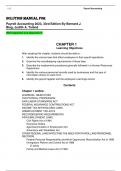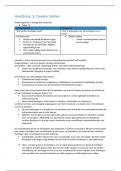1–2 Payroll Accounting Solution Manual For Payroll Accounting 2023, 33rd Edition By Bernard J. Bieg, Judith A. Toland With Appendix A & Appendix B CHAPTER 1 Learning Objectives After studying this chapter, students should be able to: 1. Identify the various laws that affect employers in their payroll operations . 2. Examine the recordkeeping requirements of these laws. 3. Describe the employment procedures generally followed in a Human Resources Department. 4. Identify the various personnel records used by businesses and the type of information shown on each form. 5. Identify the payroll register and the employee’s earnings record . Contents Chapter 1 outline: LEARNING OBJECTIVES THE PAYROLL PROFESSION FAIR LABOR STANDARDS ACT FEDERAL INSURANCE CONTRIBUTIONS ACT INCOME TAX WITHHOLDING LAWS UNEMPLOYMENT TAX ACTS RECORDKEEPING REQUIREMENTS FAIR EMPLOYMENT LAWS Civil Rights Act of 1964 Executive Orders Age Discrimination in Employment Act Americans with Disabilities Act OTHER FEDERAL LAWS AFFECTING THE NEED FOR PAYROLL AND PERSONNEL RECORDS Federal Personal Responsibility and Work Opportunity Reconciliation Act of 1996 Immigration Reform and Control Act of 1986 E-Verify Family and Medical Leave Act of 1993 Chapter 1 1–3 Uniformed Services Employment and Reemployment Rights Act of 1994 Employee Retirement Income Security Act of 1974 Disclosure Requirements Affordable Care Act of 2010 (ACA) Applicable Large Employers (ALEs) Small Employers OTHER STATE LAWS AFFECTING THE NEED FOR PAYROLL AND PERSONNEL RECORDS Workers’ Compensation Laws Disability Benefit Laws HUMAN RESOURCES AND PAYROLL ACCOUNTING SYSTEMS HUMAN RESOURCES SYSTEM Job Descriptions Requisition for Personnel Application for Employment Referen ce Inquiry Hiring Notice Employee History Record Change in Payroll Rate Terminating an Employee RECORDKEEPING SYSTEM Employee Access —Personnel Files PAYROLL ACCOUNTING SYSTEM Payroll Register Employee’s Earnings Record Paycheck Outsourcing Payroll KEY TERMS KEY POINTS SUMMARY 1. B 2. D 3. F 4. A 5. H Matching Quiz (p. 1–27) 6. I 7. J 8. C 9. E 10. G 1–4 Payroll Accounting © 2023 Cengage®. May not be scanned, copied or duplicated, or posted to a publicly accessible website, in whole or in part. Questions for Review (p. 1–27) 1. The Fair Labor Standards Act sets the minimum wage rate, and the current mini- mum wage rate is $7.25 an hour. 2. To meet the requirements of the FLSA, the employer must keep records providing the following information with respect to each employee’s wages earned: a. Day and time of day when workweek begins b. Regular hourly rate of pay c. Basis of wage payments d. Hours worked each day e. Hours worked each week f. Daily or weekly straight -time pay g. Amount and nature of exempt pay h. Weekly overtime pay i. Total additions to or deductions from wages j. Total remuneration for payroll period k. Date of payment l. Payroll period 3. FICA levies taxes on employers and employees to finance the Federal Old -Age and Survivors’ Trust Fund, the Federal Disability Insurance Trust Fund, and the Health Insurance Plan —Medicare. SECA also imposes taxes on the net earnings of the self-employed individual. 4. The taxes paid to the federal government (FUTA tax) are used to pay the state and federal administrative expenses incurred in operating the overall unempl oyment in - surance program. The taxes paid to the various state governments (SUTA tax) are used to pay the unemployment compensation benefits to the qualified unemployed workers. 5. The unfair employment practices prohibited by the Civil Rights Act of 1964, a s amended, include: a. Discriminating in hiring, firing, promoting, compensating, or in any other condition of employment on the basis of race, color, religion, sex, or national origin. b. Unions may not include or segregate union members on these bases. c. Employment agencies may not refer or refuse to refer applicants for employment on the basis of race, color, religion, sex, or national origin. 6. The purpose of the Age Discrimination in Employment Act (ADEA) is to prohibit discrimination on the basis of age in the employment practices of employers, employment agencies, and labor unions that are engaged in an industry affecting interstate commerce. Chapter 1 1–5 © 2023 Cengage®. May not be scanned, copied or duplicated, or posted to a publicly accessible website, in whole or in part. 7. A key exception is executives who are 65 or older and who have held high policy -
making positions during the two -year period prior to retirement. If such an employee is entitled to an annual retirement benefit from the employer of at least $44,000, the employee can be forcibly retired. 8. The Walsh -Healey Public Contracts Act covers laborers for contractors who furnish materials, supplies, articles, and equipment to any agency of the United States, provided the minimum contract amount is $15,000. 9. The employer is required to offer the employ ee as many as 12 weeks of unpaid leave. The leave may be used all at once, or in separate weeks, days, or hours. 10. ERISA was designed primarily to ensure that workers covered by private pension plans receive benefits from those plans in accordance with their credited years of service with their employers. 11. Vesting conveys to employees the right to share in a retirement fund in the event they are terminated before the normal retirement age. The vesting process is linked to the number of years needed for workers to earn equity in their retirement plans and to become entitled to full or partial benefits at some future date if they leave the company before retirement. Once vested, a worker has the right to receive a pension at retirement age, based on years of covered service, even though the worker may not be working for the firm at that time. 12. The administrator must furnish a statement, not more than once in a 12 -month period, of the total benefits accrued and accrued benefits that are vested, if any, or the earliest date on which these accrued benefits will become vested. 13. Employers with 50 or more full -time employees during the previous year (applicable large employers) are required to provide insurance coverage for all full -time em - ployees and their dependents. 14. The procedure that may be followed by the Human Resources Department in hiring new employees is: a. Receive request for new employee. b. Examine appli cations. c. Interview applicants. d. Administer tests. e. Check references. f. Select and notify successful applicant. g. Send information to Payroll Department. h. Prepare personnel file.





